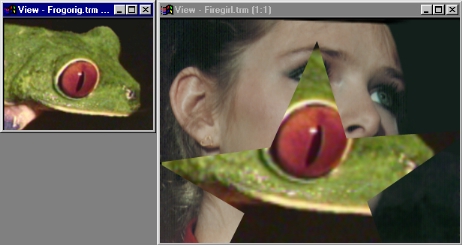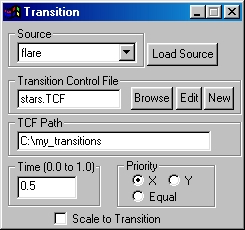| This is a child page. You can use Parent in the quick nav bar at the top or the bottom of the page to navigate directly back to the parent of this page. Some child pages are more than one level deep, and in that case will require more than one Parent click to reach the outermost document level. |
§ 16.69 - Transition
| Quick Reference to Scripting Command |
| a=TRANSITION(time[0.0-1.0], PRIORITY[0,1,2], SCALE, "path", "filename") |
| Items in CAPS are 0/1 or ranges with more options than just 0/1. Ranges other than 0/1 are indicated by brackets, such as [0-2]. |

F/x provides a powerful tool for creating scene-to-scene transitions. Every aspect of the transition is controllable by you, the user. The transition information is stored in Transition Control files, they normally carry the extension ".TCF" (more below).
§ 16.69.1 - Transition Controls
§ 16.69.1.1 - Trends
Operator dialog controls that have a Trend button next to them offer animation functionality. Trend allows you to set that variable over a set of frames. Each frame of the animation can be thought of as a slice of time. The trends allow you to alter some, all, or none of the variables for a particular time slice. Variables that have multiple states can be set to any of a number of values in the trend. Variables that are either on or off can only have an on or off value in the trend. You will notice that the trend graphs have equidistantly spaced vertical lines. Each of these lines represents a frame in the animation. The number of frames can be altered using Sequence controls... in the TimeLine pull down menu. Animation lengths of 100 - 999 frames will be represented with a vertical bar being 10 frames, and animation length greater than 1000 frames will have a vertical bar for every 100 frames. Click here to view more information on Trends.
§ 16.69.1.2 - Transition Control Files
How to make Transition Control Files
Transition does not have a trend option. It's portable to any part of the timeline, as long as a starting and ending state are brought in and defined explicitly.
§ 16.69.1.3 - Source
This chooses the end-result of the transition. To use a currently loaded image, use the drop-down box. To use an image not currently loaded, select "Load Source."
§ 16.69.1.4 - TCF Path & Source File
Together, these hold the information regarding the location of the Transition Control File. "Source File" contains the actual name of the TCF. "TCF Path" contains the directory in which the TCF is contained.Browse allows you to search your computer for the location of the Transition Control File.
Edit allows you to edit the Transition Control File with F/x's built-in quick edit window.
New opens up the quick edit window and allows you to save your new Transition Control File.
F/x's quick edit window will only keep up to 64000 characters. Files in excess of 64000 characters must be done with an outside text editor.
This parameter functions within the TimeLine, which will accept different strings at any level. For example, the timeline will accept a filename or password at any frame, and that will become the current setting at any particular time.
§ 16.69.1.5 - Time
This number ranges from 0 to 1. If a transition is defined to change over time, this will allow for "snapshots" or certain times in the transition. It can also be manipulated in the timeline to produce an animation.
§ 16.69.1.6 - Priority
Equal: This priority will scale the source image to the size of the action image.
X: This priority will scale the source image to the action image so that x-widths match.
Y: This priority will scale the source image to the action image so that y-widths match.
§ 16.69.1.7 - Scale to Transition
This determines if the image inside the transition will stay in place, or if it will grow as the transition grows.
If you want to scale to transition, the aspect ratio of the figure you create must match the aspect ratio of the source image, or it will be distorted. Also, if the scale to transition in selected and the polygon goes off the screen, it will warp as part of the selection stays on screen.
, Previous Page . Next Page t TOC i Index o Operators g Glossary
Copyright © 1992-2007 Black Belt Systems ALL RIGHTS RESERVED Under the Pan-American Conventions
WinImages F/x Manual Version 7, Revision 6, Level A

